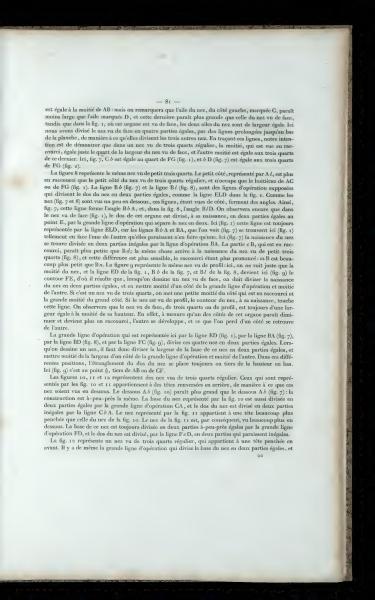Page 81
The width of the nose's wing on the left side, marked C, appears narrower than the wing marked D, making it seem larger than the nose's front view, even though in figure 1, both wings are equal in width from the front. Here, the front view of the nose divides into four equal parts by lines extending down, dividing three other nose views. These lines show that, in a typical three-quarters view, the shortened half matches a quarter of the face-on view's width, while the other half equals three-quarters of this view. In figure 7, C equals a quarter of FG in figure 1, and BD in figure 7 equals three-quarters of FG in figure 1.
The figure f is the same nose in a three-quarter reduction view. The small side, shown by AT, is more foreshortened than the regular three-quarter view, occupying only one-eighth of AC or FG (fig. 1). Lines B b (fig. 7) and B l (fig. 8) are hypothesized lines dividing the nose's back equally, similar to line ELD in fig. 1. Viewed from slightly below, these lines form angles. In fig. 7, this line forms the angle B at t, and in fig. 8, angle B l/D. Again, the nose's back (fig. 1) divides equally at point E, by a main line separating the nose. In figure 1, it’s re-represented by ELD, lines B b and A t B a (fig. 7) look combined here (fig. 1). In fig. 7, the nose is split into unequal parts by the operation BA line. The shortened part seems smaller than B/a. The figure rests at the nose's base in the small three-quarters view (fig. 8); this alteration is more apparent due to a more pronounced foreshortening: M’ba much smaller than Bn. Figure g shows the same nose in profile; you only see the nose’s half, with line ED of fig.1, B b of fig. 7, and B2 of fig. 8, becoming the contour FE in fig. 9. Thus, when drawing a nose from the front, divide equally between its operation line. One half lies along one side of it, and the major half along the other. If viewed three-quarters, set the small half on the foreshortened side and the large on the opposite. In profile, the nose’s base touches the line. The front, three-quarters, and profile noses all maintain equal width to half their height. As one side foreshortens, the opposite side appears extended, balancing the appearance.
The key line, seen here by line ED (fig. 1), by EB (fig. 7), by BD (fig. 8), and by FG (fig. 9), divides four nose views equally. To draw correctly, divide the nose’s base width into halves with this leading line in various positions, with its breadth at a third of the height beneath. In fig. 9, this is point b, a third of AB or CF.
Figures 10, 11, and 12 show typical three-quarters view noses. Those in fig. 10 and fig. 11 belong to heads tilted backward, making the noses viewed from below. Bottom A b in fig. 10 seems bigger than bottom A b in fig. 7; construction is nearly identical. The base marked in fig. 10 also splits into halves by the leading operation CA, with the back unequally divided by line C b A. The fig. 11 nose is from a much more tilted head than fig. 10. Thus, fig. 11’s nose is seen more from below. This nose’s base also splits nearly equally by the FD line, with the back divided by line F e D into unequal parts. Fig. 12 shows a nose in standard three-quarters view belonging to a head tilted forward, again with a line splitting the base into equal parts in both views.
